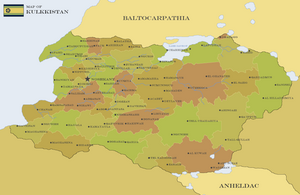Kulkkistan
Udonovi Republic of Kulkkistan جمهوری اودونوی کولکستان | |
|---|---|
Motto: خدا، کشور، انقلاب، وحدت "God, Country, Revolution, Unity" | |
Anthem: Anthem of the Akhist Revolution | |
 | |
| Capital and | Noshkant |
| Official languages | Phresian |
| Recognised national languages | Predominantly Phresian 15% Kudvoni 8% Amonian 2% Kulkkan Norter 3% other |
| Ethnic groups (2004) | Predominantly Kulkkistani 15% Kudvonite 8% Amotroic 5% other |
| Demonym(s) | Kulkkistani |
| Government | Unitary theocratic Akhist socialist republic under a totalitarian dictatorship |
| Ali Tarrokh | |
| Ali Tarrokh | |
| Taghi Dara | |
| Bahman Yekta | |
| Enayat Qanbari | |
| Legislature | Akhist National Assembly |
| Establishment | |
| 867 AD | |
| 1382 | |
| 1898 | |
| 18 September 1980 | |
| 5 May 1989 | |
| Population | |
• 2009 estimate | 82,772,094 |
• 2002 census | 80,002,634 |
| GDP (PPP) | 2010 estimate |
• Total | $349,752,850 |
• Per capita | $3,843 |
| GDP (nominal) | 2009 estimate |
• Total | $223,152,958 |
• Per capita | $2,212 |
| Gini (2007) | 32.8 medium |
| HDI (2008) | medium |
| Currency | Kulkkistani sudri (KSD) |
| Date format | dd/mm/yyyy |
| Driving side | right |
Kulkkistan, officially the Udonovi Republic of Kulkkistan, is a country located in far-western Ardentia, with a coastline stretching across the x sea. It is bordered to the north by Baltocarpathia, to the south by the Ansalonian States, and to the southeast by Anheldac. It also has a population of over 80 million, and a size of over x square kilometers, with the country being divided into a number of geographical and political regions. Its capital, as well as its largest city, is the western city of Noshkant, with a population of over 12 million. Other major population centers in Kulkkistan include Afahd, Sarvendaj, and Abyerabad.
Kulkkistan is one of the world's oldest civilizations, with Phresians first arriving and developing in the area in the fourth millenium BC. As they continued to develop, different city-states and political entities would emerge in the region, and importantly, different warlords and leaders would make attempts to unify the area, with a number of different wars taking place. By the 9th century AD, a clear force had manage to become victorious, that being the Vayzer dynasty, who successfully took over remaining resistance in southeast Phresia. Under the early Vayzers, the city back then known as Toninsia, today known as Noshkant, would be founded and designated capital of the Phresian Empire. Phresia had also started to flourish, as their position on the coast of Ardentia would allow for merchants and travellers to cross through the lands of Phresia, allowing them to be taxed so that Phresia could generate substantial income. Alongside this, they also participated heavily in regional trade, with different Vayzers all contributing to opening the nation up to global trading systems. It was also at this time that Phresia would undergo a large religious conversion, with many Phresians converting to Akhism. Although this lead to internal religious conflict, the upcoming Vayzers would soon transition Phresia into an Akhist nation as a whole.
Under Vayzer Aqim Huloal in the late 19th century, the empire would undergo significant changes and reforms. One of these main changes was switching from the use of the name 'Phresia' to the use of the name 'Kulkkistan', as it had become more popular to describe the general region in which the empire was located in. Alongside this, a peasant rebellion and a declining position on the world stage had caused Kulkkistan to being declining, with a weakening economy and military. This soon led to Huloal taking his reign towards a more authoritarian route, choosing to seize absolute power gradually as he disbanded any semblance of a democratic section within the government. Over the next few decades, this would only worsen, as different Vayzers expanded upon this approach, restricting more and more civil liberties. By the late 1970s, a weak political situation and economy, combined with mass repression and foreign exploitation of Kulkkistan, would lead to the 1980 Kulkkistani Revolution, overthrowing Vayzer Abdhu Suleiman and bringing Supreme Leader Ali Tarrokh to power, who decided to follow the main concepts of Udonovism, establishing the Udonovi Republic shortly after he was brought to power.
Today, Kulkkistan is ruled as an Akhist Republic with a presidential system that is completely dysfunctional, as Tarrokh, along with holding ultimate power as the country's Supreme Leader, is president of the nation. The Kulkkistani government is extremely authoritarian and has attracted widespread criticism for its constraints, violations of human rights, and forming an image of Tarrokh bein some sort of semi-god within Akhism. Kulkkistan is also considered a middle power, due to its influence when it comes to revolutionary groups in the region and even globally, as well as becoming somewhat self-reliant due to the cessation of trade by several important trade partners following the 1980 revolution. It is also a member of the League of Nations, however has remained heavily critical of the organization, along with many other international groups. The people of Kulkkistan are multicultural and comprise a wide variety of ethnic, linguistic, and religious groups.

